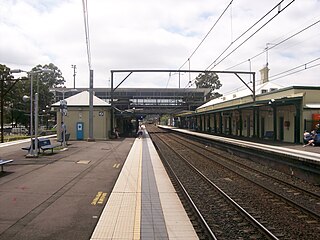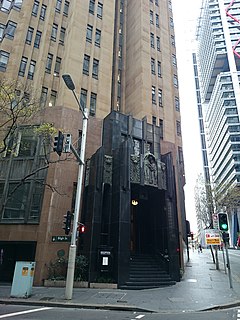
The Canterbury railway station is a heritage-listed railway station located on the Bankstown line at Canterbury in the Canterbury-Bankstown Council local government area of New South Wales, Australia. The station is served by Sydney Trains T3 Bankstown line services. The station was designed by New South Wales Government Railways and built from 1895 to 1915 by J. J. Scouller. It is also known as Canterbury Railway Station group. The property is owned by RailCorp. It was added to the New South Wales State Heritage Register on 2 April 1999.

St Marys railway station is a heritage-listed former goods yard, railway signal box and now railway station located on the Main Western line in the western Sydney suburb of St Marys in the City of Penrith local government area of New South Wales, Australia. The station is served by Sydney Trains T1 Western line services. The station marks the end of the four-track section of the Main Western line. It was designed by New South Wales Government Railways and was built in 1862. It is also known as St. Marys Railway Station Group and St Marys Railway Station. The property is owned by RailCorp, an agency in the Government of New South Wales. It was added to the New South Wales State Heritage Register on 2 April 1999.

Penrith railway station is a heritage-listed railway station located on the Main Western line in the western Sydney suburb of Penrith in the City of Penrith local government area of New South Wales, Australia. It was designed by New South Wales Government Railways and the 1863 building was built by M. and A. Jamison and D. Forest. It is also known as Penrith Railway Station group. The property is owned by RailCorp, an agency of the Government of New South Wales. It was added to the New South Wales State Heritage Register on 2 April 1999.

The Lithgow railway station is a heritage-listed former station master's residence and railway station and now guest accommodation and railway station located on the Main Western line at Railway Parade, Lithgow, City of Lithgow, New South Wales, Australia. It was designed and built by New South Wales Government Railways and built from 1924 to 1925. It is also known as Lithgow Railway Station Group and Residence and Eskbank East. The property is owned by RailCorp, an agency of the Government of New South Wales. It was added to the New South Wales State Heritage Register on 30 August 2013. The station has frequent NSW TrainLink services running to and from Sydney Central.

Bankstown Bunker, formerly known as Air Defence Headquarters Sydney, is a heritage-listed defunct Royal Australian Air Force (RAAF) operations facility, located on the corner of Marion and Edgar Street, in Condell Park, Canterbury-Bankstown Council, New South Wales, Australia. It was designed by Allied Works Council and built from 1943 to 1944 by Stuart Bros Pty Ltd of Sydney. It is also known as Air Defence Headquarters Ruin Sydney (former), No. 1 Fighter Section Headquarters, 1FSHQ, Bankstown Bunker and RAAF No. 1 Installation Bankstown; No. 101 Fighter Sector. It was added to the New South Wales State Heritage Register on 18 November 2011.

Toowoomba railway station is a heritage-listed railway station on the Western line at Russell Street, Toowoomba, Toowoomba Region, Queensland, Australia. It serves the city of Toowoomba, which is the junction for the Western, Main and Southern lines. The station has one platform with a passing loop, opening in 1867. It was designed by FDG Stanley and built in 1873 by R. Godsall. It was added to the Queensland Heritage Register on 21 October 1992.

The Paddington Post Office is a heritage-listed post office located at 246 Oxford Street in Paddington, a suburb of Sydney, New South Wales, Australia. The post office is owned and operated by Australia Post, an agency of the Australian Government. The building was also a former telephone exchange. It was designed by the New South Wales Colonial Architect’s Office under James Barnet and later Walter Liberty Vernon, and was built by William Farley. The building was added to the Commonwealth Heritage List, the New South Wales State Heritage Register on 22 December 2000, and the Register of the National Estate.

Auburn Railway Signal Box is a heritage-listed railway signal box on the Main Suburban railway line, Auburn, New South Wales, Australia. It was designed by New South Wales Government Railways (NSWGR) and built in 1954 by the NSW Department of Railways. It is also known as Railway Signal Box. The property is owned by RailCorp. It was added to the New South Wales State Heritage Register on 2 April 1999. The rear of the building faces Rawson Street, Auburn, opposite 171 Rawson Street.

Sydney Airport Air Traffic Control Tower is a heritage-listed air traffic control tower at Lawrence Hargreaves Drive, Sydney Airport, New South Wales, Australia. It was added to the Australian Commonwealth Heritage List on 22 January 2016.

Temora Post Office is a heritage-listed post office at 173 Hoskins Street, Temora, New South Wales, Australia. It was added to the Australian Commonwealth Heritage List on 8 November 2011.

Marrickville Post Office is a heritage-listed post office at 274A Marrickville Road, Marrickville, Sydney, New South Wales, Australia. It was added to the Australian Commonwealth Heritage List on 22 August 2012.

Ayr Post Office is a heritage-listed post office at 155 Queen Street, Ayr, Shire of Burdekin, Queensland, Australia. It was designed by the Commonwealth Department of Interior and was built in 1936. It was added to the Australian Commonwealth Heritage List on 22 August 2012.

Bowen Post Office is a heritage-listed post office at 46 Herbert Street, Bowen, Queensland, Australia. It was designed by the Commonwealth Department of the Interior and constructed in 1936. It was added to the Australian Commonwealth Heritage List on 8 November 2011.

Stanthorpe Post Office is a heritage-listed post office at 14 Maryland Street, Stanthorpe, Southern Downs Region, Queensland, Australia. It was designed by John Smith Murdoch of the Queensland Government Architect's office and was built by D. Stewart and Co in 1901. It was added to the Australian Commonwealth Heritage List on 22 June 2004.

The City Mutual Life Assurance Building is a heritage-listed commercial building located at 60-66 Hunter Street, in the Sydney central business district, in the City of Sydney local government area of New South Wales, Australia. It was built during 1936. It is also known as CML Building and 10 Bligh Street. It was added to the New South Wales State Heritage Register on 2 April 1999.

Hamilton Post Office is a heritage-listed post office at 57 Gray Street, Hamilton, Victoria, Australia. It was designed by C. H. E. Blackman of the colonial Public Works Department under the aegis of William Wardell, built in 1876, and occupied in 1878. It was added to the Australian Commonwealth Heritage List on 8 November 2011.

Kyneton Post Office is a heritage-listed post office at 113 Mollison Street, Kyneton, Victoria, Australia. It was designed by Peter Kerr of the colonial Public Works Department and built in 1870-71. It was added to the Australian Commonwealth Heritage List on 8 November 2011.

Maryborough Post Office is a heritage-listed post office at 69 Clarendon Street, Maryborough, Victoria, Australia. It was designed by John Hudson Marsden and built in 1876-77, with the clock tower added in 1879. It was originally built as a combined court house, post and telegraph office and Colonial office, though the post office alone has occupied the building since 1892. It was added to the Australian Commonwealth Heritage List on 8 November 2011.

Castlemaine Post Office is a heritage-listed post office at 202 Barker Street, Castlemaine, Victoria, Australia. It was added to the Australian Commonwealth Heritage List on 8 November 2011.

Parafield Airport Air Traffic Control Tower is a heritage-listed Air traffic control tower at Kittyhawk Lane, Parafield, South Australia, Australia. It was added to the Australian Commonwealth Heritage List on 22 January 2016.






















